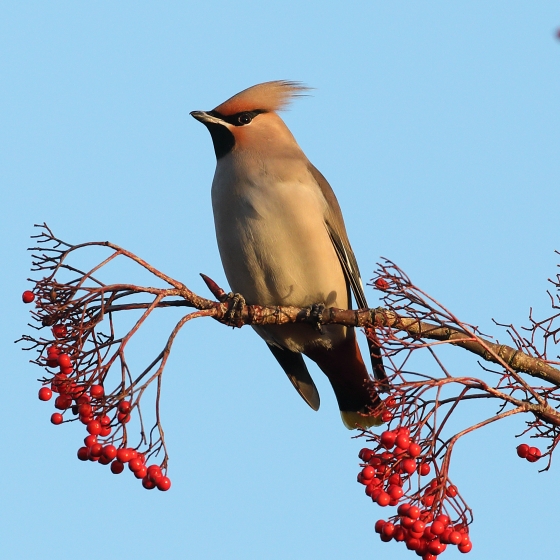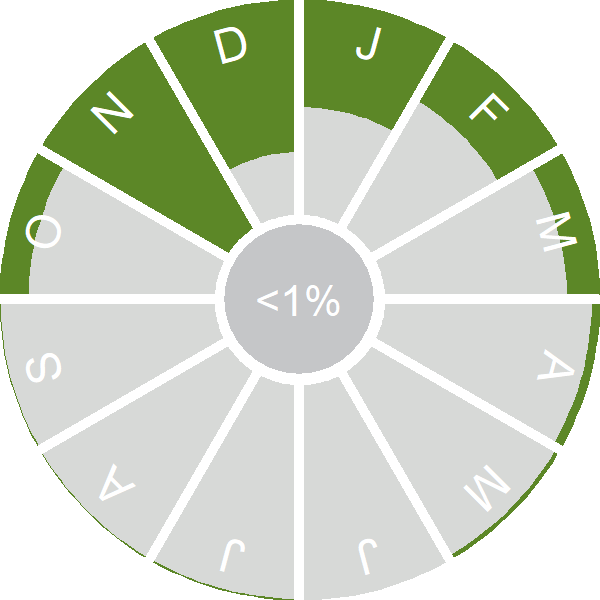Waxwing
Bombycilla garrulus (Linnaeus, 1758)
WX
 WAXWI
WAXWI  10480
10480

Family: Passeriformes > Bombycillidae

Pinky-buff and crested, the Starling-sized Waxwing is an irruptive visitor to the UK during the winter months.
Waxwings come to the UK in search of berries when crops run low closer to their breeding grounds in Fennoscandia and western Russia. As such can turn up at anytime during the winter and in varying numbers. This behaviour is known as ‘irruptive’ as, if berries remain plentiful in northern Europe very few Waxwings, if any, will move.
The Waxwing’s favoured berry is that of the Rowan and during ‘Waxwing winters’, they can gather in large flocks at just a few Rowan trees. Waxings can turn up anywhere in the UK, but are less commonly reported in western regions than further east.
Identification
Waxwing identification is usually straightforward.
SONGS AND CALLS
Listen to example recordings of the main vocalisations of Waxwing, provided by xeno-canto contributors.
Call
Develop your bird ID skills with our training courses
Our interactive online courses are a great way to develop your bird identification skills, whether you're new to the hobby or a competent birder looking to hone your abilities.
Browse training coursesStatus and Trends
Population size and trends and patterns of distribution based on BTO surveys and atlases with data collected by BTO volunteers.
CONSERVATION STATUS
This species can be found on the following statutory and conservation listings and schedules.
DISTRIBUTION
Waxwing numbers vary annually, with irruptions occurring when Fennoscandian Rowan berry crops fail. Birds arrive in the Northern Isles and along the North Sea coast, where they can remain in large numbers if berries there are abundant. If the berry crop is poor, or as it becomes depleted, birds move south and west in search of food. During 2007–11 there were two major irruptions, in autumns 2008 and 2010. During the latter, severe weather brought about increased competition with resident species for berries and resulted in a mass exodus of Waxwings from parts of Scotland, with many being resighted subsequently as far away as the English south coast.
Occupied 10-km squares in UK
| No. occupied in breeding season | 1 |
| % occupied in breeding season | 0.03 |
| No. occupied in winter | 1703 |
| % occupied in winter | 56 |
European Distribution Map
DISTRIBUTION CHANGE
The irruptive nature of Waxwings mean no two atlases are the same. The irruption and cold weather in 2010 contributed to a more-than-tenfold increase in range size at 10-km scale compared to during 1981–84.
| % change in range in winter (1981–84 to 2007–11) | +898.7% |
SEASONALITY
Waxwing is a winter visitor with numbers fluctuating widely from year to year; arrivals typically from late October onwards and may linger into early spring.

Movement
Information about movement and migration based on online bird portals (e.g. BirdTrack), Ringing schemes and tracking studies.
An overview of year-round movements for the whole of Europe can be seen on the EuroBirdPortal viewer.
RINGING RECOVERIES
View a summary of recoveries in the Online Ringing Report.
Foreign locations of birds ringed or recovered in Britain & Ireland

Biology
Lifecycle and body size information about Waxwing, including statistics on nesting, eggs and lifespan based on BTO ringing and nest recording data.
BIOMETRICS
Wing Length 
|
Adults | 117.3±2.5 | Range 113–121mm, N=723 |
| Juveniles | 117±2.3 | Range 113-121mm, N=293 | |
| Males | 117.6±2.5 | Range 114–121mm, N=369 | |
| Females | 117.1±2.5 | Range 113–121mm, N=321 |
Body Weight 
|
Adults | 58.1±4.61 | Range 51.0–66.0g, N=650 |
| Juveniles | 57.5±5.8536 | Range 48.3–66.0g, N=263 | |
| Males | 58.1±4.68 | Range 51.0–66.0g, N=329 | |
| Females | 58.1±4.57 | Range 51.0–66.0g, N=291 |
Feather measurements and photos on featherbase 
CODES & CLASSIFICATION
Ring size 
|
B+ |
Field Codes 
|
2-letter: WX | 5-letter code: WAXWI | Euring: 10480 |
For information in another language (where available) click on a linked name
Links to more information from ConservationEvidence.com
Would you like to search for another species?











Share this page